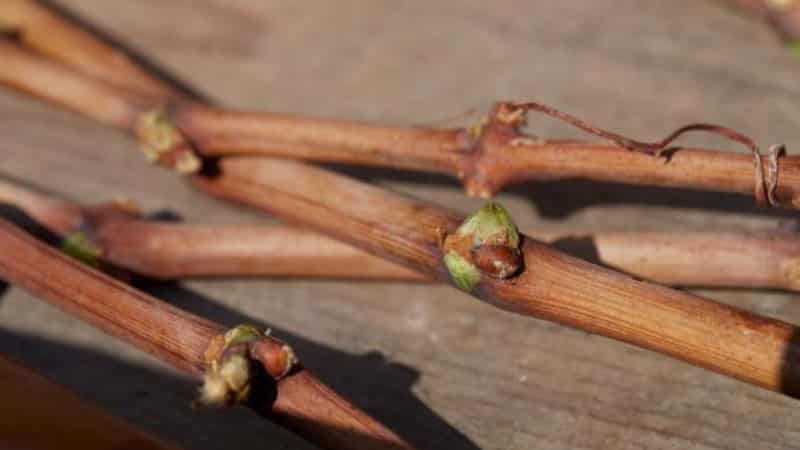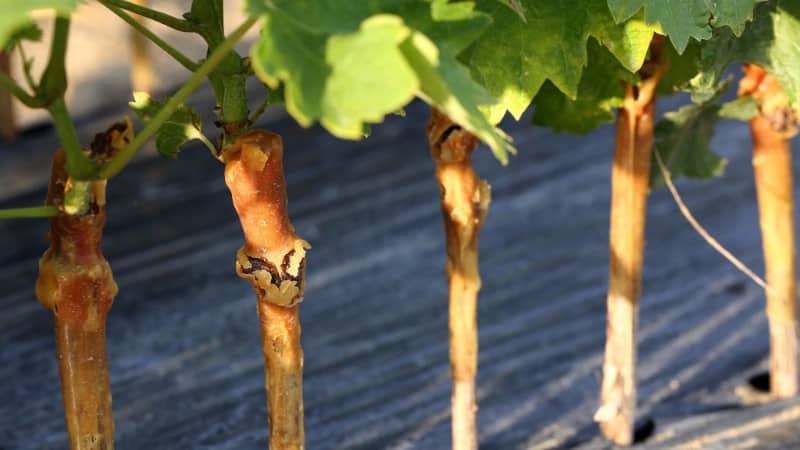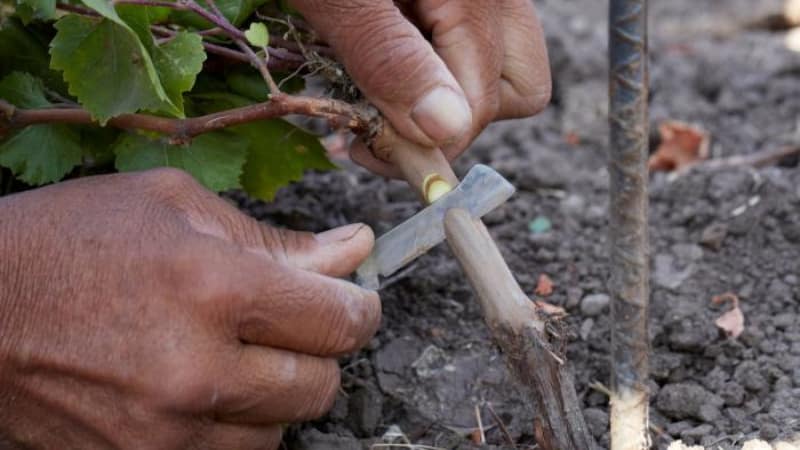Step-by-step instructions for grafting grapes in the fall
Grape grafting is an agrotechnical procedure that allows you to improve the properties of the plant and berries, restore the bush or replace one variety with another. There are many methods of grafting a crop, which differ in principles and timing, but more often such an event is carried out in the fall.
Read on to learn about the benefits and methods of autumn grafting of grapes.
Why graft grapes in the fall?
The plant is often grafted before winter, although spring and summer grafting are practiced. The main reason for carrying out the procedure at this time of year is the desire to get an early harvest next season.

Advantages and disadvantages of autumn vaccination
A few more advantages:
- the crop becomes more resistant to drought, high humidity, soil salinity, as well as to the grape aphid - phylloxera;
- the event increases productivity;
- the size and number of berries on the bunches increases;
- if the propagation material is selected correctly, the ripening period of the bunches is reduced;
- grape bushes become compact when it is possible to graft two shanks onto the rootstock at once;
- the old bush is rejuvenated - the life and fruiting period increases.
Disadvantages of grafted seedlings:
- low yield of grafted standard seedlings from school, rarely more than 50%;
- a large number of poor-quality fusion of the scion and rootstock (incomplete or one-sided);
- bushes may fall out due to scion rejection;
- bushes damaged by frost do not recover due to growing rootstock;
- fragility of grafted plantings - they often break when they are laid on the ground when covering for the winter.
Grafted seedlings are more capricious than rooted ones and require more careful care, but the result in the form of increased productivity and sustainability of the crop is justified.
Timing of the procedure
In autumn, the optimal time for grape propagation is the end of the growing season, that is, October or early November. It is still quite warm then, the air temperature remains within +15°C, and the ground temperature is at least +10°C.
Important! Grafting of grapes is carried out with a margin of 2-3 weeks before the onset of frost.
Goals

Tinting improves the quality of the vine by combining the best qualities of the scion plant and the rootstock bush.
Winegrowers use grafting for different purposes:
- Replace the variety with a new one without planting a seedling, using the already developed root system.
- Without uprooting a bush that does not produce new shoots (due to freezing, damping off, damage by rodents, etc.), restore the green mass in two seasons.
- Quickly propagate rare or expensive varieties.
- Reduce susceptibility to diseases.
- Increase the frost resistance of grapes by using cold-resistant rootstocks.
- Increase the tolerance of certain varieties of soils that are unsuitable for them - too acidic, calcareous, arid or, on the contrary, with a high groundwater level.
- Grafting several stems of different varieties onto one rootstock at once not only saves space, but also decorates the vineyards, which will produce clusters that differ in color and shape.
- Improve the taste and external qualities of the berries: certain combinations of rootstock and cuttings can affect the taste and size of the grapes.
Preparation of scion and rootstock
When preparing the mother bush for the procedure, it is carefully cut off. Only a standard 8-12 cm high is left. The cut must be clean from rot, signs of other diseases, and traces of insect damage. The stem is cleaned of bark, dust, dirt and treated with a 1% solution of copper sulfate, after which it is touched only with sterile instruments. The cut of the trunk must be even and smooth.
For high-quality grafting of any variety, you need to properly prepare the cuttings. They are harvested at the end of October or beginning of November, taking into account the following recommendations:
- The event is held before the start of frost.
- Carefully select a healthy, high-yielding bush. The vine on it should be mature and have tough, yellow-brown bark.
- Cut grafts-scions 10-20 cm long.
- Leave 2-3 eyes on each of them, carefully clearing them of whiskers and stepsons.
- Then the chibuki are kept for a day in a solution of heteroauxin, a growth stimulator (0.1 g per 1 liter of water).
- Then it is dried and treated with paraffin. It protects the cutting from drying out and improves its survival rate. The chubuks are dipped into melted paraffin for a few seconds and then quickly lowered into cold water.
- If the grafting procedure is planned for winter or spring, the scions are stored in a hole, sprinkled with sand or in the refrigerator at a temperature not exceeding +5°C.
To obtain high-quality grafting material, do not use the top part of the vine, as well as damaged, thin or crooked stems.
How to graft grapes correctly
In the autumn, the plant is often grafted into a split trunk onto a bush that has given a poor harvest in recent years. The success of the procedure depends on the correct execution of the splitting and preparation of the shanks.
Description of different methods
For autumn, the most effective method is considered to be grafting into a bush. The stem is a small part of the trunk (up to 15 cm), located above the root above the ground. This method is used in cases where the scion does not need to form its own root system.
The procedure begins with preparing the instrument. You will need a sharp knife and pruning shears disinfected in potassium permanganate or alcohol. After processing, they should not be placed on the ground. You will also need a hammer, bandage, twine and copper sulfate.
Next, everything is performed according to the following algorithm:
- The stems are cut from the bottom of the stem at an acute angle.
- The same cut is made on the other side of the cutting. The result is a double-sided pointed end in the form of a wedge 2-4 cm long at a distance of 1-1.5 cm from the lower bud.
- The cuttings are immediately immersed with the cut side in water. Do not touch the cuts with your hands.
- In the trunk, a split is made with an ax, the depth of which corresponds to the length of the cut part of the scion cutting. In other cases, the split is performed differently: a screwdriver is placed in the center of the cut and driven in with a hammer to the required depth.
- The cutting is inserted into the hole so that the lower bud remains outside, and the cambial layers of the scion and rootstock overlap each other.
- If the rootstock has a large diameter, then another shank is usually inserted into it. The remaining space is filled with toilet paper, previously soaked in water.
- The rootstock and scion are tightly pulled together using a bandage, elastic film or strips of fabric.
- Additionally, the grafting site is secured with twine.
- To preserve moisture and protect from frost, the grafting site is additionally covered with clay and wrapped in cloth.
- Then the soil around the root circle is loosened and watered.
- After the water has gone into the ground, the bush trunk is covered with earth so that the grafting sites remain above the surface.
- As a covering material, take a five-liter bottle with a cut off neck and place it upside down on a grafted stem.
With the onset of spring, the shelter is gradually removed. If the weather is warm, the container is raised for several hours and then put back. So, within a month the plant adapts to new conditions and then the shelter is completely removed.
Even in the autumn, the grafting is done at the root. In this case, the trunk is underground. The maximum depth is 10 cm. The method differs only in the height at which the connection is made. The procedure is as follows:
- The soil around the bush trunk is removed to a depth of 15-20 cm, and the underground part is cleared of old bark.
- The root stem is cut down 6-8 cm above the top node.
- Then they split to a depth of 5-6 cm and insert one or two cuttings, sharpened on both sides, with the buds facing out.
- The cracks and the grafting site are covered with clay, wrapped in cloth or film and carefully covered with soil 6-7 cm above the scion buds.
- Then water well and cover with new soil on top. In winter, the grafted plant is covered with hay or straw, and covered with spruce branches on top.
Green to green grafting is the fastest and easiest way that does not require prior preparation. After cutting the stems, they are immediately grafted onto the bush.The copulation method is usually used when the scion and rootstock are of the same thickness.
The main condition is to complete the procedure as quickly as possible so that the sections do not have time to dry out. To reduce the amount of evaporated moisture leaves trimmed half.
In the butt is a suitable grafting method for warm regions with insufficient humidity. The procedure is also simple. A part of the bark with a bud is removed from the selected scion and applied to the same cut made on the rootstock. The better the cut parts match in size, the better the quality of fusion. If after a few weeks the grafted cutting produced a swollen bud, then the technology was correct.
Copulation is a more complex, but most reliable method. The thickness of the scion and rootstock should be the same for better alignment of the cambium layers.
Important! Whatever grafting method is used, the gardener’s task is to ensure a tight fit of the cuttings to the rootstock, then there will be a greater chance that parts of the crop will take root safely.
Mistakes to Avoid
Sometimes cuttings do not take root due to mistakes made during the grafting procedure. The most common of them:
- Different ripening times and growth vigor for the rootstock and cuttings.
- The split is too deep. Moist air enters the wide gap, causing rot.
- The cut was made with a blunt instrument, so it turned out rough and bacteria formed on it.
- The cuttings were not treated with paraffin; as a result, they lost a large amount of moisture, dried out and did not take root.
- Juice flows out of the plant abundantly, therefore the grafting site is tied too tightly. This negatively affects the survival of the cuttings.
Further care of grafted grapes

With proper care for grafted grapes, you can get a rich and tasty harvest from the new bush as early as next season.
To do this, experienced gardeners perform the following steps:
- Protection is installed over the young plant. The best option is a plastic bottle with a cut bottom.
- The grafted grapes are regularly watered and hilled. Both drying out and waterlogging of the soil should not be allowed.
- Observe the plant. If after two weeks young shoots have not appeared on the grafted cuttings, re-grafting is done.
- autumn plant fed phosphorus-potassium mineral fertilizers.
- In spring, the cover is removed and the soil around the bush is loosened. Fertilize with organic or complex mineral fertilizers with a predominance of the nitrogen component.
This is interesting:
Proven ways to preserve grapes for the winter at home.
How and when to open grapes after wintering.
When and how to properly transplant grapes to another place in the fall.
Conclusion
If you take the vaccination process responsibly and follow the instructions, you will definitely achieve the desired result. Grafting makes the plant more resistant to external factors and increases productivity. The main thing is to provide the plant with optimal conditions and proper care after grafting.